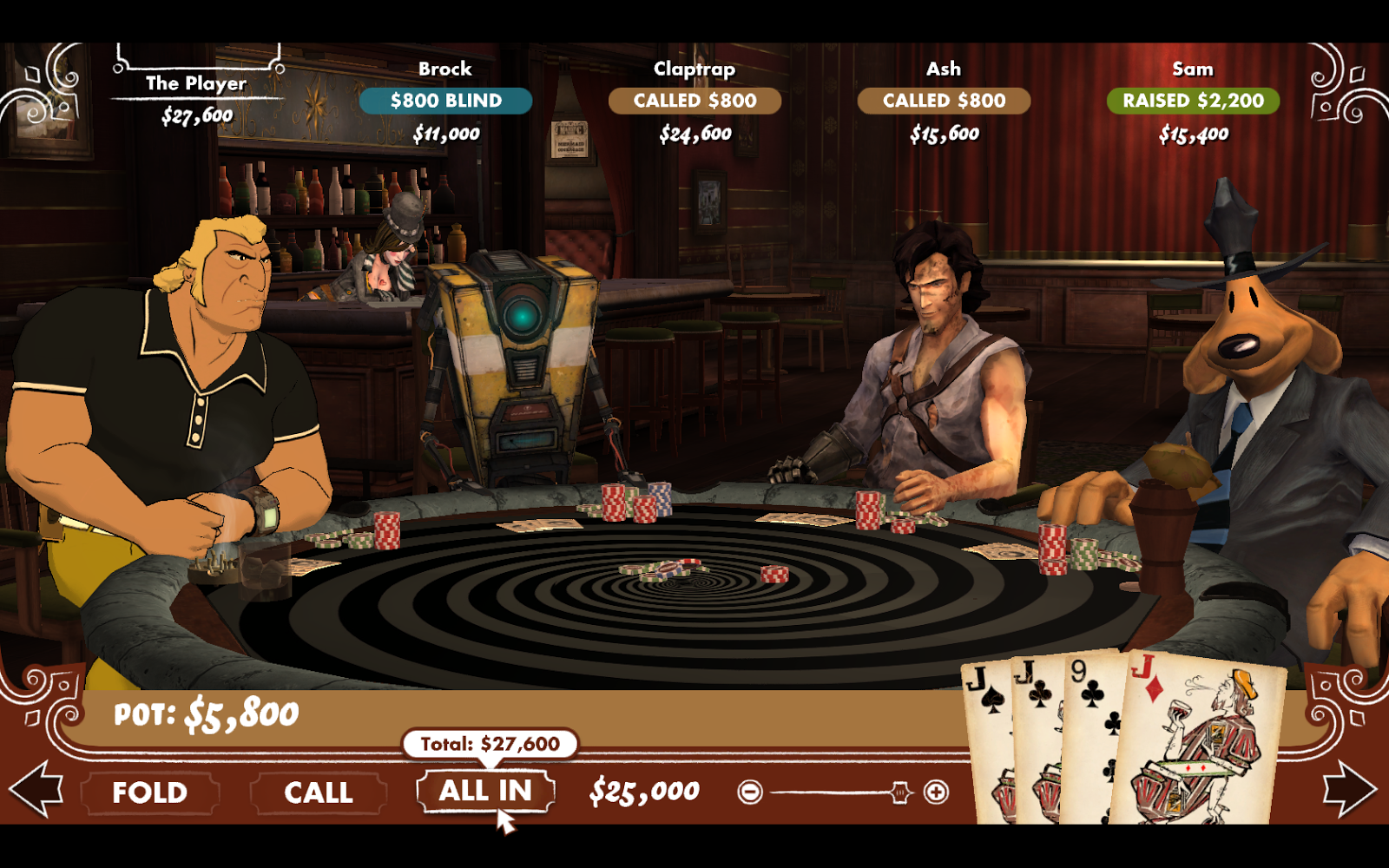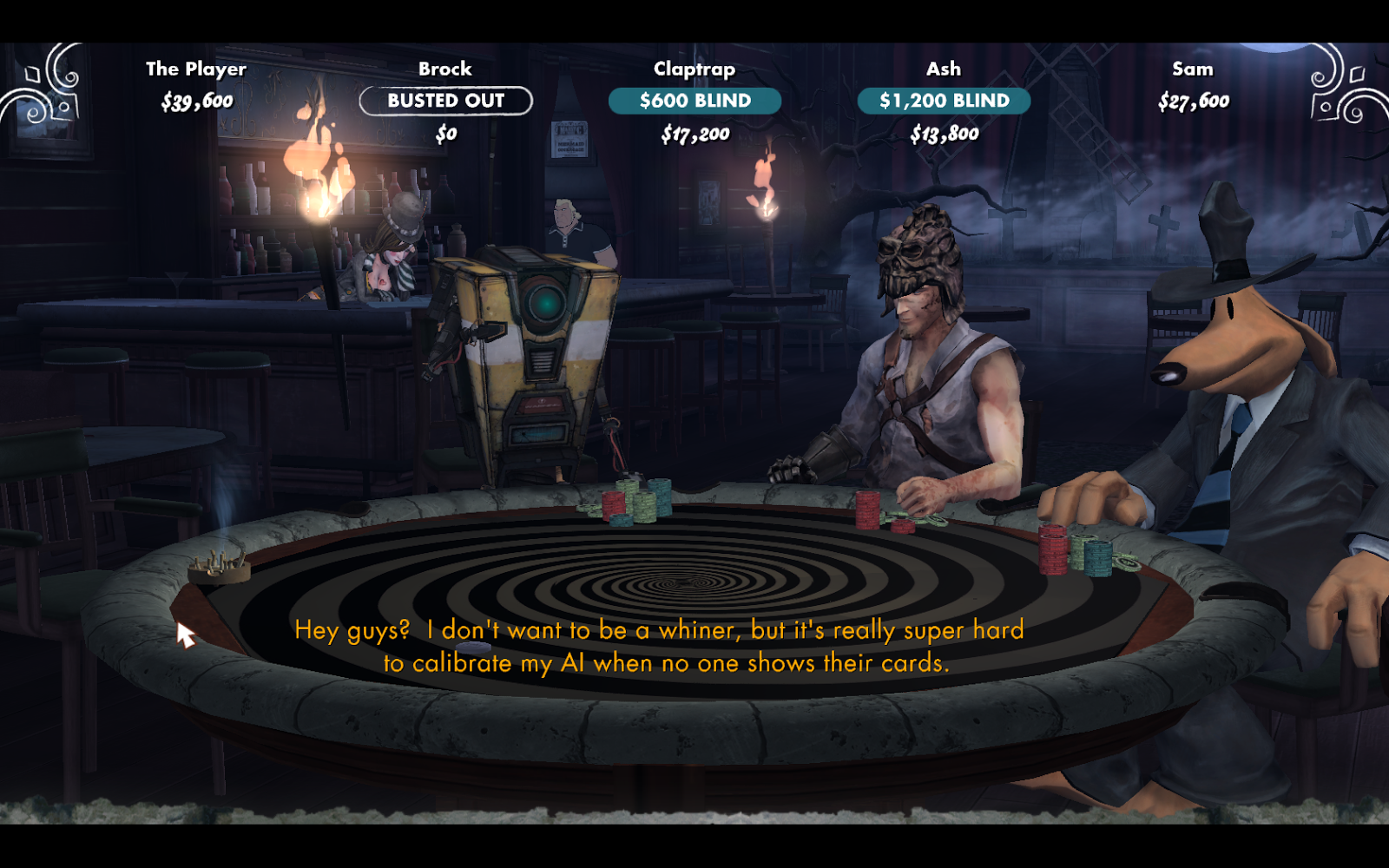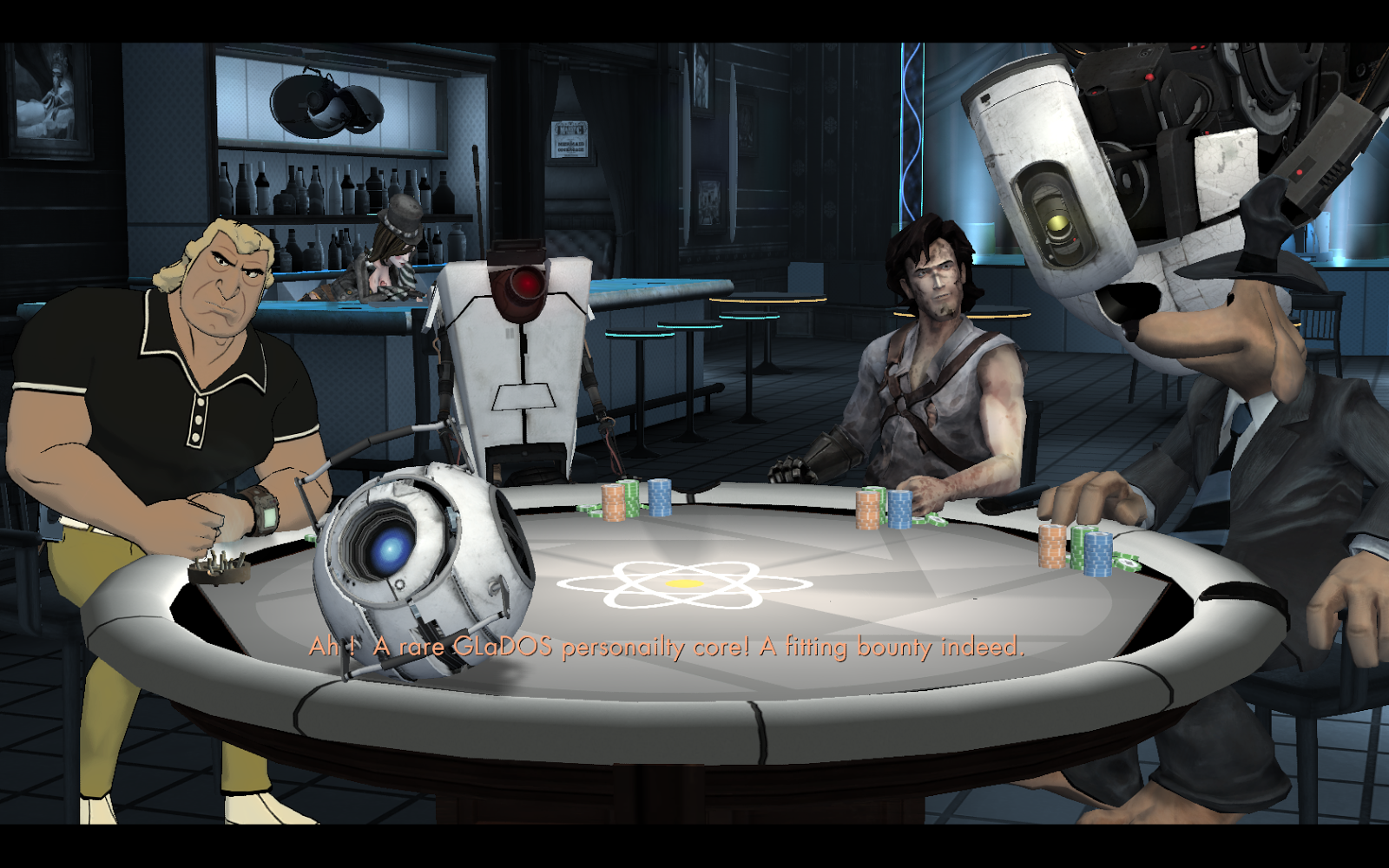It’d be easy to say that Poker Night 2 is the same game as
the previous incarnation, since, after all, you are still literally playing the
same game of Texas Hold ‘Em, only redone with a few new cards and tables, and a
new cast of characters, but there are some major fundamental differences
between the two games, even if, as I said, you’re still just playing poker.
The first major improvement to the franchise is the
inclusion of a second style of poker, called Omaha. For those of you without poker
knowledge, Texas
Hold ‘Em is a special style of poker. In standard poker each player is dealt
his or her own cards, but Texas
utilizes a set of communal cards. At the start of a round every player is dealt
two cards, called hole cards (if you’ve ever heard the phrase, ace in the hole,
this gives you an idea of what it means). Bets are placed, and everyone who
didn’t already have to pay a small amount called a blind, must match that to
proceed. Three cards are then placed on the table, which every player will use
to make a five card hand. This is called the flop. Another round of betting ensues,
followed by a fourth card. This is followed by another round of betting, and
then a fifth card is placed on the table. Assuming anyone is left at this
point, a final round of betting is allowed, and then everyone still in the game
must flip over their cards, where the best five card combination of the seven
available cards (two hole cards and 5 community cards) wins.
That’s Texas Hold ‘Em. In itself, it’s a fun game. However, Omaha is a bit different.
Rather than each player having 2 hole cards, each player gets four. The five
community cards are still played in the same fashion as Texas, but there is one
major twist that fouls up the idea of, say, having 3 of a kind in the hole, or
a flush with 4 community cards. You see, in Omaha you must play 2 and only 2
hole cards, and 3 and only 3 community cards. That makes it quite frustrating
when you have a King, Queen, and 10 in the hole, which would work nicely with
the Ace and Jack found in the communal cards, but because of the 2/3 rule, you
don’t have a high straight/royal flush, you actually have a high card (this has
happened to me more than a few times).
 |
| While this might look like I have a great hand (a high straight), since this is Omaha, the best I have is a pair of Aces. |
That’s improvement number 1, because doubling the play modes
makes the game substantially better. Improvement 2 comes from an enhanced AI,
or at least something like an AI that I’ll attribute an increase in difficulty
to. You see, this game’s four celebrities are Brock Samson (from the Venture
Brothers show), Claptrap (from the Borderlands series), Ash Williams (The Army
of Darkness movie), and Sam (from the same Sam and Max series as Max in the
first game), and each one has a different personality/playstyle. Brock and Sam
both seem to be aggressive players that always have the cards to match. Ash is
the one I’ve been most successful in baiting into betting big on bad cards, or
basically calling his bluff, though he does seem to get pretty lucky on that
fourth or fifth card. Claptrap bets big, but seems to fold a lot if you reraise
on him.
The above personalities are further enhanced through the use
of “tells” or some action that it supposed to let you know what the other
character is “thinking.” Brock smashing his fist against the table and
grimacing seems to proceed a fold, more often than not, but sometimes he calls.
Sam may have his hat fly up into the air. Supposedly these tells give you an
advantage, and they can be enhanced by purchasing a drink through a rewards
system I’ll get to in a little bit, but I’m not so sure that’s how this all
really works. I’ve seen Brock play a hand, which, based on the tell, I assumed
was bad, only to find out he had excellent cards. Similarly, with Sam’s
extremely noticeable tell, I’ve seen him fold a hand or lose poorly. This whole
system may be more complex (or I’m overthinking it) than I realize, but the end
result is that it was sustainably more difficult to win a tournament than in
the previous game, and I found that I had to play for several hours before my
first victory, which was on Omaha anyways, while I seemed to win every 2nd or
3rd tournament before.
 |
| I never really found drinks to be worth it, partly because of the cost, and partly because the tells never seemed to give me the kind of information I really wanted. |
The third improvement concerns unlocking items. This happens
in a couple of ways, but the first thing I’d like to cover is the tie ins
between this game, Team Fortress 2, and Borderlands 2. The first game had
several items you could unlock in Team Fortress 2 if you acquired them in Poker
Night, which was ultimately the reason I bought the game, thanks to an
achievement associated with unlocking The Heavy’s Iron Curtain weapon that
entered you in a competition to win every game on Steam, which, given my frugal
ways, was something I was more than happy to do. But back to the unlocks. In
the first game there was a chance every tournament that a character would use a
special item as the buy in, and whoever knocked out that character would
receive the item. So if Tycho took The Heavy to the cleaners before you got a
chance, tough luck. You would just have to wait until that item came up again.
Now you must first complete a set of three randomly selected challenges, which
unlocks the ability to acquire an item. From that point until you actually get
it, a random character will put in his or her special item, giving you a chance
each tournament.
At first I was a fan of this new system. The challenges were
things that could be accomplished within a few full tournaments, such as
beating an opponent with a higher kicker (you have the same hand, say a pair of
Aces, but you have the next highest card, a King to his Queen), causing
everyone to fold before seeing the first three cards, winning a tournament, or
buying everyone a round of drinks. After that, it’s simply a matter of winning
your next tournament to get the item (though that’s not the easiest task in the
world). Then I came to a challenge I just couldn’t complete – knock another
player out after he has gone all in where you win with a high card. I had done
this a few times in the original game, mostly because those characters seemed
to over bet or bluff quite often. Here, getting someone to go all on when they
had nothing is pretty unlikely. Worse is the chance that, in a two person
showdown, no one has a pair, straight, or flush. Between two people there are a
total of 9 cards, and only two can be the same (one of each player’s hole
cards). You can’t have more than 4 consecutive cards, otherwise someone has a
straight, so if you have an Ace/King, and the other player has a King/Queen,
then a 10, 9, 8, 7, and 5 would be adequate for this challenge. Note that that
requires 8 specific cards out of 13. Oh, and I’m pretty sure this isn’t even
possible in Omaha.
The worst part was this was my final challenge for my final item. The solution
ended up requiring quite a bit of cheating. You see, one of the
flaws/exploits/saviors in this game is the ability to Alt+F4 before a hand ends
to not have it saved, allowing you to come back and replay the whole thing.
That’s great if you are really trying to get something, or you just want to win
quickly. So when you get another player low enough at the end of a tournament
that he is going to go all in every time, you just keep replaying the hand over
and over again until you complete the challenge. In my case it took over 2
hours of playing 30 seconds to 1 minute at a time before I had high enough
cards and a stupid pair didn’t show up at the last second. Note, that’s 2 hours
in game time, not real world time, so there was plenty of rebooting the game
going on there.
 |
| Most of the challenges are pretty straight forward, and easily enough accomplished, especially since you can complete them across multiple tournaments. |
You may be wondering how you go about unlocking these
things, since obviously the redone levels and special scenarios seem like fun
little additions to the game. That’s where the improvement comes in.
Previously, you had to win enough tournaments to unlock new cards and tables,
with the final item taking 21 wins to unlock. Now you buy everything, including
the tell enhancing drinks, with coins. You get coins by finishing better than
dead last, with the amount scaling by how well you do. The winner gets 100
coins, while second gets 50, third 20, and fourth 10. Since some of the items
in sets cost several hundred coins, it’s apparent that you’ll need to win
plenty of tournaments to acquire items quickly, but at least with this setup,
you gain something even if you don’t finish first every time, allowing you to
still unlock everything.
 |
| Okay, why hasn't someone produced these as real playing cards yet?!?! I mean, look at the Queen, it's awesome! Oh, and the King involves cake! |
So, the final breakdown:
Score: 7/10
Suggest Price: $2.50 (Lowest was $0.99)
*****
For more Poker Night 2, check out this collection of screenshots otherwise unused in
this review. Click on any one for a large image.















































































I have Poker Night 2 on PS3 courtesy of PSPlus, it's unbelievably bad.
ReplyDeleteConstant lagging, stutters, outright pauses for long periods of time.... I mean 20 odd seconds at a time for no apparently reason. Just atrocious. It's bad enough that one would have to seriously wonder if the developer ported it to PS3 just to promote PC gaming.
Never played Poker Night 1 on PC, but I do have the first one. Which needless to say runs perfectly fine, as you'd expect. Since this isn't exactly something that should be particularly demanding on... well, any hardware pretty much.
That...is rather unfortunate. Not that this is a game you should be super worked up to play, but it is a shame that it doesn't run well. However, I can somewhat approve of the idea of a dev poorly porting to a console in order to promote the PC, mostly because I'm stick if it happening the other way. Turnabout is, after all, fair play.
ReplyDelete